One
Great Year Archive – I
This
feature discusses a season in which a team finished much higher than they
did in the immediate past or future or a player far surpassed any other
year of his career.
1899:
Buck Freeman, Washington Senators
John
Frank "Buck" Freeman startled the baseball
world in 1899 by clouting 25 HRs for the Washington
Senators of the National League.
- Buck combined the power that season with a .318 average, 25 doubles,
25 triples, and 122 RBI. His slugging percentage (retroactively
computed) was .563.
- His 25 HRs was considered the record
until Babe Ruth came along. Like Babe, Buck was a former southpaw P turned left-handed
slugger.
Freeman
never hit more than 13 round-trippers in any other of his
11 big-league seasons.
- However, from 1899 through 1905,
he led all major leaguers with 77 blasts, 49 ahead of second
place Nap Lajoie.
- Unlike other batters
of his era, Buck took a wide stance and
swung from the heels.
|

Buck Freeman |
Buck
was adept at intentionally fouling pitches he didn't want.
- This
practice was actually illegal in his era when foul balls did
not count as strikes, but umpires commonly ignored it.
- One day
in 1899, though, umpire Hank O'Day enforced
the rule against Buck, calling a strike when
he fouled off a Cy Young delivery.
- Freeman was a forerunner of the workout sluggers of the 1990s. He kept
himself in shape in the off-season by walking 12 miles a day
in addition to going to the local gym in Wilkes Barre PA for
weightlifting, parallel bars, boxing, and other exercises.
When
the NL downsized from 12 to 8 teams for the 1900 season, Washington
was one of the ousted franchises.
- So Buck moved
to the Boston Braves for a year before jumping to the new American League, where
he played for the Red Sox from 1901-1906.
- For his career, he hit more triples (131) than
homers (82).
Reference:
Deadball Stars of the American League, SABR
|

Dutch Leonard
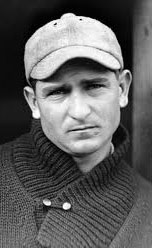
Rube Foster
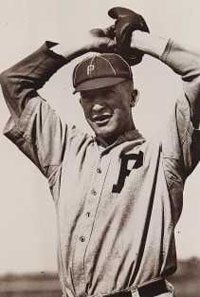
Grover Cleveland Alexander
|
Hubert "Dutch" Leonard holds the record for the lowest ERA in a season, 0.96, for the Boston Red Sox in his second ML season in 1914.
- He would never have another season with a winning percentage of .792 or an ERA under 2.17, primarily because he did everything in his power to alienate every team he played for.
- His story will involve draft dodging during World War I and an incident that nearly ruined the reputations of two future Hall of Famers.
The stocky southpaw (5'10" 185 lb), built "more like a football player than a baseball player," reported to the Red Sox for spring training in 1913
- He won 22 games at Denver of the Western League the season before, striking out 326 in 241 innings. But he had already given an indication of what a difficult employee he would be by getting suspended for insubordination in the middle of the season. It would not be his last suspension.
- Dutch (so-called because "he looked like a Dutchman") had a fairly good rookie season with Boston:
14-17, 2.39 ERA, 144K and 94W in 259 1/3 innings.
- The 94 walks showed that he needed to improve his control. But he showed a promising fastball and a sharp-breaking curve.
Leonard fulfilled all his potential in 1914.
- It took him four starts to win his first game, but after he lost May 30 to make his record 4-3, Dutch didn't lose again until August 13. At that point, his mark was 16-4 after twelve consecutive victories during which he struck out 91 in 116 innings.
- Leonard finished 19-5 for the second place Red Sox. Earned Run Average was in its second year as an American League statistic. His 0.96
ERA was 0.74 (3/4 of a run) lower than teammate Rube Foster's, which was second in the junior circuit.
- That ERA mark, compiled in the pre-1920 "dead ball era," remains the lowest in a single season since the "modern" baseball era began in 1901.
- Dutch twirled seven shutouts and allowed just a single run in ten other starts. He surrendered more than two runs in a game four times and never allowed more than four in any start.
Dutch didn't build on his great season to forge a Hall of Fame career.
- Sean Deveney summarizes what happened like this:
After '14, Leonard didn't much apply himself, routinely reporting overweight, earning a reputation as a late-night carouser and chronic complainer.
- Receiving a raise of $5,000 a year, he came to spring training in 1915 out of shape and started only three games the first six weeks of the season.
- The Red Sox suspended him in late May for insubordination for accusing owner Joseph Lannin of mistreating his players.
- Returning to the rotation in July, he posted a 15-7 record and 2.36 ERA. He also led the league in strikeouts for the second consecutive year despite many so much lost time.
- He won Game 3 of the World Series, besting Phillies' ace Pete Alexander, 2-1.
Part of the reason Leonard seemed so indifferent to baseball success may have been the fact that he invested his money wisely.
- He purchased a grape ranch just east of Fresno CA and earned a sizeable income off that enterprise for the rest of his life.
- The ranch grew to 2,500 acres and allowed Dutch to build a mansion on the land.
Leonard was a solid pitcher for Boston in 1916 and '17.
- He worked 528 2/3 innings over the two campaigns, winning 34 and losing 29. However, he developed a reputation of ducking the good teams in order to fatten his record on the weak sisters.
- Despite a declining strikeout rate, Dutch pitched his first no-hitter on August 30, 1916, 4-0 over the St. Louis Browns.
- That Fall he won his second and last World Series start, 6-2 over Brooklyn in Game 4.
External matters intervened in 1918 to end Dutch's tenure with the Red Sox.
To be continued ...
Reference: " Dutch Leonard," David Jones, SABR Biography Project
The Original Curse: Did the Cubs Throw the 1918 World Series to Babe Ruth's
Red Sox and Incite the Black Sox Scandal? Sean Deveney, 2010
Top
of Page |
With the U.S. embroiled in the Great War in Europe during the 1918 season, baseball players faced public pressure to enter the military.
- The Federal government ruled that men who worked in an essential industry were exempt from the military draft. So many ML players left their teams to work at shipyards in order to circumvent induction into the army. Others enlisted in the Navy to avoid serving in the infantry in Europe.
- With his talents eroded by age and lack of care, Leonard started the season slowly and resorted to smearing the ball with licorice, a practice that was spreading throughout the league. Since the league seemed indifferent to the cheating, imposing a minimal fine on pitchers' caught in the act, umpires simply threw out the doctored ball and continued the game.
- Dutch threw his second no-hitter on June 2 but, twenty days later, took a job with the Fore River shipyard in Quincy MA and pitched for the company team the rest of the season.
After the war ended in November, 1918, Leonard returned to the AL but not with the Red Sox.
- Before the start of the '19 season, Boston traded Leonard with two other players to the New York Yankees. But Dutch immediately became a salary holdout, demanding his entire year's salary be deposited into a savings account. So the Yankees sold his rights to the Detroit Tigers for $10,000.
- Relying more and more on the spitball, Dutch spent the next three years with the Tigers, winning 35 and losing 43. Since he had started throwing the pitch before the owners banned it, he was among the "grandfathers" allowed to continue to use the spitter.
- Prior to the '22 season, he became embroiled in a salary dispute with Detroit owner Frank Navin. So Dutch played for hometown Fresno in the independent San Joaquin League. Since this action violated the reserve clause that bound a player to one team, he was suspended indefinitely from "organized baseball."
- He returned to the Tigers for the 1924 and '25 campaigns. However, he battled manager Ty Cobb, who had disliked Leonard from his days with the Red Sox. Cobb would later say that Dutch was one of only two players he intentionally spiked. "Leonard played dirty - he deserved getting hurt," Cobb told biographer Charles Alexander.
- Cobb got his revenge on Dutch by deliberating overusing him despite warnings from the team physician. As an example, Cobb let Dutch "take one for the team" against the Athletics on July 14, 1925 to the tune of 12 runs and 20 hits. Even the opposing manager, Connie Mack, warned Ty, "You're killing that boy."
- Cobb put Leonard on waivers and maneuvered behind the scenes to make sure no other team claimed him. Then he traded him to Vernon of the Pacific Coast League. Leonard surprised no one by refusing to report, thus ending his professional baseball career. Dutch was particularly hurt that Tris Speaker, his former Red Sox teammate and manager of the Cleveland Indians, didn't claim him.
Early in the next season, Leonard tried to gain a measure of revenge against Cobb and Speaker.
- Dutch came East from California in May, 1926, and told Navin and AL President Ban Johnson that he had evidence that Cobb, Speaker, and Indians outfielder Joe Wood conspired to throw a game and make money by betting on the outcome.
- The contest in question took place on September 24, 1919, the day after the Indians had been eliminated from the pennant race. According to Leonard, Speaker proposed that the Indians lose the game to the Tigers to help Detroit finish third. Cobb, Speaker, and Wood placed bets on Detroit, which won, 9-5. Leonard claimed he bet $1,500 on the contest but won only $130.
- To corroborate his story, Leonard produced two letters written to him shortly after the end of the 1919 season, one from Cobb and one from Wood.
- With the 1919 Black Sox scandal fresh in everyone's mind, Johnson and Navin believed Leonard and paid him $20,000 for his silence. No fan of Cobb, with whom he had run-ins for years, Johnson confronted Ty and Tris after the season. Despite their vigorous denials, Ban banned them from further participation in his league.
- After resigning and agreeing to keep quiet about the real reason for their "retirement," Cobb and Speaker changed their minds, hired lawyers, and brought Commissioner Kennesaw Mountain Landis into the case. Johnson considered Landis his mortal enemy because Ban could no longer rule his league with an iron hand. The antipathy was mutual.
- When Landis launched his own investigation, he concluded that the letters were by no means conclusive. Both made reference to bets, but neither stated specifically what the bets involved or even whether they were even on the game in question.
- Landis visited Leonard in California. But when the judge invited Dutch to come to Chicago to testify, the ex-pitcher, stubborn as ever, refused. So Landis exonerated Cobb and Speaker and reinstated them.
To his dying day, Leonard refused to talk about his controversial career.
- His nephew told a sportswriter:
Many times we pleaded with him to sit down and put it on a recording - the highlights of his career - but he never felt in the mood, and when he was not in the mood he wasn't about to do anything regardless of what it might be.
- Divorced and childless, Leonard died in 1952, leaving an estate worth an estimated $2.1 million.
Reference: "Dutch Leonard," David Jones, SABR Biography Project
The Original Curse: Did the Cubs Throw the 1918 World Series to Babe Ruth's
Red Sox and Incite the Black Sox Scandal? Sean Deveney, 2010
"Leonard, Cobb, Speaker Affair," Bill Burgess, BaseballGuru.com
Top
of Page |
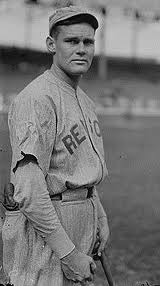
Dutch Leonard
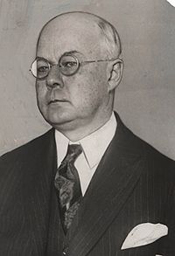
Frank Navin

Ban Johnson
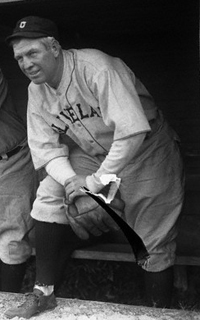
Tris Speaker
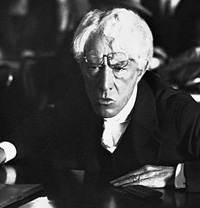
Kennesaw Mountain Landis
|
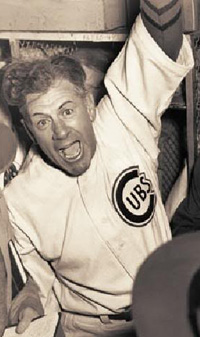
Charlie Grimm |
Baseball
teams prepared for the 1945 season in the hopes that World War
II would end soon so that the many players in the service could
return for the '46 season.
- The Chicago Cubs sought to regain the glory that won them pennants in 1929, 1932,
1935, and 1938. C
- harlie Grimm, the skipper
for the '32 and '35 NL titles, had returned to the helm early
in the '44 season and guided the team to a fourth-place finish,
their highest since 1939.
- Grimm fielded this lineup for the '45 season. (Final 1945 stats shown.)
Player |
Avg. |
RBI |
HR |
| 1B
Phil Cavarretta |
.355 |
97 |
6 |
| 2B
Don Johnson |
.302 |
58 |
2 |
| SS
Lennie Merullo |
.239 |
37 |
2 |
| 3B
Stan Hack |
.323 |
43 |
2 |
| LF
Peanuts Lowrey |
.283 |
89 |
7 |
| CF
Andy Pafko |
.298 |
110 |
12 |
| RF
Bill Nicholson |
.243 |
88 |
13 |
| C
Mickey Livingston |
.254 |
23 |
2 |
Starting
pitchers: Hank Wyse (R), Paul Derringer (R), Claude Passeau (R), and Ray
Prim (L).
|
The Cubs leaped out of the gate, winning 7 of the
first 9.
- However, that momentum flagged and the club finished
7-4 for April and only 11-11 for May, good for fourth, 6.5 out.
- June saw improvement to 14-11, a warmup for July, when Chicago caught fire, winning 26 of 32. The team seized first place with
a DH sweep of the Phillies on July 8 and would not relinquish their grip the rest of the
season.
- The lead peaked at 7 on August 19 and hovered around
3-4 games most of the way.
A
major reason the Cubs maintained their lead
was the purchase of RHP Hank Borowy from the Yankees for $97,000
on July 27.
- Added to the starting rotation for the stretch, Hank won 11 and lost only 2 with a 2.13 ERA.
(His combined record for the season was 21-7.)
- He pitched the
pennant-clinching victory on Saturday, September 29, 4-3 in Pittsburgh.
- The
final margin was 3 games over the three-time defending champion Cardinals. Chicago finished 98-56 (.636).
- Wyse led the staff with 22 wins, while Passeau had
17, Derringer 16, and Prim 13. The starters amassed 86 complete games and were first (Prim),
second (Passeau), and fifth (Wyse)
in the league in ERA. Cavaretta won MVP primarily
because of his league-leading .355 average.
In
1945, making the World Series was not that big a deal for Cubs fans.
- This was the tenth appearance in the Fall Classic for
the North Siders.
- However, they had not prevailed in October
since back-to-back crowns in 1907-8, both over the Detroit
Tigers.
|
 |
As
everyone knows, the Cubs lost that World Series
in seven games to the Tigers,
who were greatly aided by the return of Hank Greenberg
from the service late in the year. Little did Cubs
fans know that 10-year-olds among them would still be looking
for the next World Series appearance when they were in their
70s.
Most
all the players in the military returned for the '46 season.
- Chicago dropped to third (82-71) and then to
sixth (69-85) for '47.
- They would not finish higher than fifth
until 1967.
|
1950:
Jim Konstanty, Philadelphia Phillies
The
1950 Philadelphia Phillies were known as the
"Whiz Kids" because of their youth.
- GM Bob Carpenter
Jr. (son of the owner who bought the team in 1943 from the NL)
had assembled a talented young team for manager Eddie
Sawyer.
- In 1949, the Phils experienced their first
winning season in 32 years, finishing 81-73 for third place.
- The 1950 infield of Eddie Waitkus 1B, Mike
Goliat 2B, Granny Hamner SS, and 3B Willie "Puddin' Head" Jones averaged
26 years of age.
- All three OFs, LF Del Ennis,
CF Richie Ashburn, RF Dick Sisler,
were under 30.
- The top three starting Ps were Robin
Roberts (23), Curt Simmons (21), and Russ Meyer (26).
- However, one of the key performers
in the Whiz Kids' magical pennant-winning season was 33-year-old Jim Konstanty.
After
graduating from Syracuse
U. in 1939, Konstanty toiled
in the minor leagues as a starter.
- One year he led the Eastern
League in losses. He strongly considered retiring from baseball
and using his PE degree as a coach.
- However, he stuck it
out and was rewarded when Cincinnati purchased
his contract in 1944, the same season the desperate Reds made 16-year-old Joe Nuxhall the youngest
pitcher in MLB history.
- Konstanty went
6-4 with a 2.80 ERA as both a starter and reliever.
After
a year in the military, he was traded to the Boston
Braves for the 1946 season but optioned
to Toronto of the International League.
- He again considered retirement
but instead developed a slider.
- He made enough of an impression
on his manager, Eddie Sawyer, that Eddie acquired Konstanty when he became manager
of the Phillies.
- Jim went
9-5 for Philadelphia in 1949 with 7 saves.
He pitched in 53 games, all in relief.
Nothing
in Konstanty's record prepared the baseball
world for his 1950 season, which culminated in the NL MVP
Award.
- He pitched in 74 games, all in relief.
- He finished
64 games, saving 22, an NL record at the time.
- His record
was 16-7 with an ERA of 2.66.
|
 |
Leading
by five games with only six to play, the Phils
proceeded to lose five in a row and had to defeat the Dodgers
on the last day to save the pennant.
- This caused Sawyer to start Roberts on only two days' rest –
his fourth start in the last eight games.
- Robin gutted out a 10-inning victory clinched by Dick Sisler's
3-run HR.
Because
of the grueling race and the loss of Simmons
to the Army on July 31, Sawyer had an exhausted
staff heading into the World Series with the Yankees.
- So the skipper surprised everyone by starting Konstanty in Game One. This was his first ML start since 1946.
- Jim pitched
quite well in a 1-0 loss.
- The Phillies dropped
two more one-run games (2-1 and 3-2) before a 5-2 defeat completed
the New York sweep.
Konstanty
pitched through 1956 but never had another season like 1950.
- After two more years in the bullpen, he toiled primarily as
a starter in 1953 (14-10, 4.43 ERA).
- The Yankees claimed him on waivers in August 1954 in one of their annual
acquisitions of veteran NL players for the stretch run.
- He pitched
in 45 games for the 1955 AL champs but did not appear in the
World Series loss to the Dodgers.
- After the Yanks released
him the following May, he pitched the rest of the season for
the Cardinals to close out his career.
|
1951:
Walt Dropo, Boston Red Sox
Walt
Dropo was born in 1923 to Yugoslavian immigrants
in Moosup CT and for that reason was called "Moose."
- However, when he grew to 6'5" 220 lb., the appellation
fit even better.
- He played football, basketball, and baseball
at the University of Connecticut.
- He turned down offers from the Chicago
Bears of the NFL and the Providence
Steamrollers of the Basketball Association of America
(forerunner of the NBA) to sign with the Boston
Red Sox in 1947 because he considered baseball
more of a challenge than the other sports. Moose was slow afoot but had a powerful looping uppercut swing.
- He appeared in 11 games with Boston in
1949 but hit only .149.
- No one could have predicted that
he would become the first Red Sox player
to win American League Rookie of the Year the following
season.
|
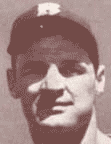 |
Playing
on a third-place team, Big Walt compiled these
numbers in 136 games in 1950.
.322
BA, .583 SLG, 28 2B, 3 3B, 34 HR, 144 RBI, 101 R
He
led the league in total bases and RBIs and made the All-Star
team.
The
very next year (1951), he broke his right wrist, and his numbers
dropped to .239, 11 HR, and 57 RBI.
- On June 3, 1952, Boston traded him to Detroit with Fred Hatfield, Don Lenhardt, Johnny Pesky, and Bill Wight for Dizzy Trout, George Kell, Johnny Lipon, and Hoot Evers.
- The
following month, Walt had a record-setting
hot streak of 12 consecutive hits. Included in the streak were
a 5-for-5 game against the Yankees and a 7-for-7 performance in a twinbill against the Washington
Senators.
- Walt's best year
with the Tigers was 1953 when he drove in 96 runs, the second most in his career.
However, he hit only .248 with 13 HRs.
- He continued with the White Sox, Reds,
and Orioles but
never came close to his rookie output.
- He retired in 1961 with
152 HRs and only five stolen bases.
Thanks
to my friend Steve, a diehard Red Sox
fan, for suggesting Walt Dropo for this feature.
|
1996:
Brady Anderson, Baltimore Orioles
Brady
Anderson, Baltimore Orioles CF, hit
50 HRs in 1996.
- This was more than double the number he hit
in any other season and almost one-fourth of the 210 four-baggers
he smashed in his career.
- Furthermore, he cranked out half-a-hundred
round-trippers batting leadoff.
- However, he finished
in second place in the AL HR derby behind Mark McGwire's
52 blasts in his last full season with the Oakland
A's.
From
Carlsbad CA, Anderson played for the California-Irvine
Anteaters before signing a pro contract with
the Red Sox after
his junior year in 1985.
- He is by far the best of the four
Anteaters who have made it to the bigs.
- He debuted with Boston in 1988 but was traded to the Orioles along
with Curt Schilling for P Mike Boddiker on July 29.
Anderson
didn't top the .231 mark until 1992.
- In that year, he became the third
player in MLB history to score 100 R, hit more than 20 HR (he
had 21), drive in 80 or more runs (he had 80 on the nose), and
steal more than 50 bases (he had 53) in a season.
- The 53 SBs
were the best of his career by 17.
- He didn't do that well the
next three seasons.
|
|
1993
.263, 87 R, 13 HR, 66 RBI
1994 .263, 78 R, 12 HR, 48 RBI
1995 .262, 108 R, 16 HR, 64 RBI
Nothing
in these statistics save the 108 R would have predicted his
1996 success.
1996
.297, 117 R, 50 HR, 110 RBI
His
21 SB put him in the company of only Willie Mays
(1950) as players with 50+ HRs and 20+ SBs in a season. Ken
Griffey Jr. joined the exclusive club in 1998.
|
Anderson
credited his 1996 success to strength training, diet and the
use of natural dietary supplements.
- He became a spokesperson
for EAS, distributor of performance based nutritional supplements.
- Hitting ahead of Roberto Alomar, Rafael
Palmeiro, Bobby Bonilla, and Cal
Ripken certainly helped him as well.
Brady
continued with the O's through 2001, then played
his last season in Cleveland
in 2002. The best he could manage in those years was a .288
average (1997), 109 R (1999), 24 HR (1999), and 81 RBI (1999).
|
1945:
Roger Wolff, Washington Senators
Roger
Wolff was a 6'0" 205 lb. right-handed knuckleballer
for the Washington Senators in 1945.
- He was
by no means unique on the Washington staff,
which boasted four starting knuckleballers. The other
three were Dutch Leonard, Johnny Niggling,
and Mickey Haefner.
- Wolff
won 38% of his career 52 victories that season, finishing 20-10.
Leonard won 17 and Haefner,
16, as the Nationals finished 87-67 for their
best record since the 99-win pennant team of 1933.
- They finished
second, one game behind the Detroit
Tigers.
Wolff
learned to throw the dipsy-doo from the mayor of his hometown,
Chester IL.
- Roger debuted with the Philadelphia
A's late in 1941, pitching only 17 innings.
- He continued with Connie Mack's club in 1942-3,
winning 21 and losing 9.
- Before the '44 season, he was traded
to the Senators for much-travelled Bobo
Newsom. However, he had a horrendous first season in
the Nation's Capital: 4-15! Wolff explained
the debacle like this:
I had constant pain in my left
shoulder. I couldn't sleep. ... I thought I had a broken vertebra,
and I went to the hospital and they told me to see my dentist.
... I had ten abscessed teeth. I got those out and ... felt
the pain just go on out of my arm.
The
tight '45 AL race was impacted by some strange scheduling.
- Because
they shared Griffith Stadium with the Redskins,
the Senators' season ended a week early on
September 23. This forced them to play more doubleheaders than
other teams.
- Wolff won his 20th on Saturday
the 22nd at Philadelphia,
2-0. After splitting a DH with the A's to complete their season on Sunday, Washington was one game behind Detroit.
- The club worked out at Bethesda Naval Base in case they had
to take the field again in a playoff game or the World Series.
- The Tigers had
only three games left. They split a DH with Cleveland at home on Wednesday before heading to St. Louis for two games with the Browns.
- The leaders needed only one win to clinch the pennant. When
the Saturday game was rained out, a DH was scheduled for Sunday.
- However, it rained some more, letting up enough to allow the
first game to start an hour late. With rain coming down hard,
1B Hank Greenberg, recently returned from the
service, stepped to the plate with the sacks loaded in the 9th and cracked
the first pitch into the bleachers for a 6-3 victory.
- The meaningless
second game was cancelled.
Wolff
slumped to 5-8 in 1946.
- He credited his downfall to a muscle
tear in his back suffered on July 4 when he twisted to catch
the toss while covering first.
- Even though Clark Griffith's
doctor told Wolff not to throw, Griff insisted he pitch, which worsened the pain. Decades later, Wolff still could not rake leaves.
- After giving it a try with Cleveland and Pittsburgh in '47, Roger was through.
|

Roger Wolff |
Reference: One
Shining Season,
Michael Fedo (1991) |
1952:
Bobby Shantz, Philadelphia Athletics.
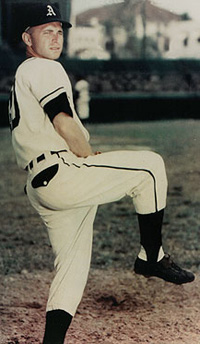 |
In
1952, 27-year-old Bobby Shantz went 24-7 for
the Philadelphia Athletics.
- Despite the fact
that the A's finished only fourth, Shantz was voted the AL MVP.
- Shantz
was extremely popular with A's fans. Attendance
spiked by 15,000 when he pitched at Shibe Park that season
(6400 to 21,000).
- On August 5, Bobby won
#20 before a sellout crowd of 35,673, with 10,000 more turned
away.
One
reason Bobby was so popular, in addition
to his skill as a pitcher and the fact that he was a Pennsylvania
boy (Pottstown), was that he was only 5'6" tall and 140
lbs!
- Cat quick, he was one of the premier fielders of his
position. He won the first four AL Gold Gloves when the award
was inaugurated in 1957.
- Yankee manager Casey Stengel described Shantz as "the best pitcher, fielder, and bunter in the AL."
Some commentators rate him the best fielding P ever.
After
serving in the Philippines near the end of World War II, Shantz
signed with Connie Mack's A's.
- Bobby pitched one season in the minors, compiling an 18-7 record
at Lincoln in the Western League.
- He jumped
to the parent club for the 1949 season because several pitchers
had arm problems, going 6-8 with a 3.40 ERA mostly in relief.
- However, he did make a dazzling debut, shutting down the Tigers in Detroit for nine innings without allowing a hit after relieving
in the third. He finally gave up a run and two hits in the
13th but earned the victory.
- The A's finished
fourth eight games over .500, only the second time that had
happened since 1933.
|
The
A's fell to the cellar in 1950.
- RHP Alex
Kellner, who had won 20 in 1949, lost 20. Bobby's
4.61 ERA was still better than the team's 5.49. His record was
8-14 with 23 starts.
- After the season, Mack,
the only manager the A's had known in the 20th
century, announced his retirement. His replacement, Jimmy
Dykes, brought new energy to spring training, where
he encouraged rumors that trades were eminent, including one
that would have sent Bobby along with 1B Ferris
Fain and three others to Boston for Ted Williams.
- Bobby improved
to 18-10 with a 3.94 ERA as the A's moved up
to sixth.
- He was selected to the AL All-Star team but did not
appear in the game.
- One of the reasons he improved was that,
with the help of pitching coach Chief Bender, Bobby developed a knuckleball as his second
pitch behind his curve.
To
start 1952, Bobby beat the defending champion
Yankees 3-1 in the
second game of the season.
- Starting in April 30, he reeled off
11 straight wins.
- On June 8 he beat Cleveland 12-4 to become the first AL P to reach double figures.
- He was
14-3 at the All-Star break. In his last game before the break, Stengel teased him that his Yankees would provide him with an early exit so that he could pitch
in the game, which happened to be in Shibe Park.
- Casey didn't start him but did bring him to pitch the fifth inning. Bobby struck out Whitey Lockman as well as future Hall of Famers Jackie Robinson and Stan Musial.
- he game was called after
five because of rain, which was a major disappointment to an
11-year old boy who was watching his first All Star game following
the extension of the "coaxial cable" to New Orleans
that summer.
By
early August, Bobby's record was 20-3.
- His
ERA was 1.54 and he had completed 21 of his 23 starts.
- A slump
at the end of August into September reduced Bobby's
record to 22-7.
- He finally defeated the lowly St.
Louis Browns on September 14 and then four-hit
the Yankees, 2-0,
before 38,000 in the Bronx who couldn't help but root for the
mighty mite. This was Shantz' fourth win over
the Bronx Bombers that season and extended his scoreless streak at Yankee Stadium
to 29 innings.
On
September 23, Bobby's season ended abruptly.
- Although he threw left, he batted right, exposing his pitching
arm. Instinctively raising his left arm to protect his face
on an inside pitch from the Washington
Senators' Walt Masterson, Bobby suffered a broken wrist.
- His final record was 24-7 with a 2.48 ERA. He beat every team but Boston at least three times. He walked only 63 in 280 innings while
fanning 152.
- The A's finished fourth (79-75),
16 games behind New York.
Bobby
never came close to matching his '52 performance.
- In 1953, he
tore a tendon in his right shoulder and missed the second half
of the season.
- Plagued by injuries, he made only two appearances
in 1954.
- He pitched through the 1964 season but never won more
than 11 games in any season for Kansas City (where the A's moved after 1954), the Yankees (1957-60, including six World Series games in '57 and '60), Pittsburgh (1961), Houston (1962), St. Louis Cardinals (1962-4), before ending back in Philadelphia with the Phillies (1964).
- In April, 1955, in Kansas City he had the pleasure of
teaming with his brother Bill behind the plate
to shut out the Yankees 6-0.
|
1955-6:
Herb Score, Cleveland Indians
Herb
Score exploded on the American League scene at age
22 like the rockets he threw from the mound.
- The 6'2" 195
southpaw began his MLB career with the Cleveland Indians in 1955. He started 32 games, completing 11.
- He won 16 and lost
10, establishing a rookie record with 245 Ks that stood until Dwight Gooden broke it in 1984.
- He also walked
154 and compiled an ERA of 2.85 in 227 innings.
- He was selected
for the All Star Game and was voted AL Rookie of the Year.
He
made the cover
of a new magazine called Sports Illustrated in
May of his rookie year.
- Robert Creamer's
article rhapsodized about the many duels fans could expect
in the years to come between Score and another
first-year fireballer, Bob Turley of the Yankees.
- Tribe manager Al Lopez had no qualms about pitching Herb in Fenway Park, traditionally a graveyard
for lefties because of the Green Monster. "I'm not afraid
to pitch Score any place or against anybody."
- Creamer wrote: "Which of the two is
faster is a subject of casual debate around the American League,
but there is little question that either one of them is much
faster than anyone else in the league." Unlike the bulkier
Turley, Score "throws
with the ball with a long, whiplike overhand motion that seems
to lack the violence of Turley's delivery.
His curve ball is considered generally to be a little more
effective than Turley's." [You can read
the complete article in SI's Vault by following the
link above.]
Herb
suffered no "sophomore jinx" in 1956 as he topped
his rookie marks across the board: 20-9, 263 K, 129 W, 2.53 ERA.
The Indians rejoiced that they had a worthy
successor to Bob Feller!
Then
tragedy struck.
- On May 7, 1957, Gil McDougald of the Yankees hit a line drive that smashed into Score's
face, breaking several bones.
- There was concern at first that
he would be blinded in at least one eye. Although he recovered
his vision completely, he missed the rest of the season.
- He
returned for 1958 but, concerned about being hit again, he
subconsciously altered his motion (like Dizzy Dean 20 years before) and was never the same pitcher again. His
velocity dropped and he became injury-prone.
- The Indians traded him to the White Sox right before the 1960 season.
- He won only 19 games after amassing
36 victories in his first two seasons.
- He struck out 147 in
1959, his last season in Cleveland, but didn't
reach triple digits in any other year.
- He called it quits
after appearing in only 8 games in 1961.
|
 |
Score
broadcast Indians games from 1964-1997.
- A year
into retirement, he was involved in another serious accident
when his car was struck by a truck in Florida. He again broke
the orbital bone around one of his eyes as well as suffering
trauma to his brain, chest and lungs.
- He spent over a month
in the intensive care unit.
- He recovered sufficiently to throw
out the first pitch at the Indians Opening Game of 1999.
|
|
CONTENTS
1899:
Buck Freeman
1914:
Dutch Leonard - I
1914:
Dutch Leonard - II
1945:
Chicago Cubs
1945:
Roger Wolff
1950:
Jim Konstanty
1951:
Walt Dropo
1952:
Bobby Shantz
1955-6:
Herb Score
1996:
Brady Anderson
One Great Year Archive - II
One Great Year Archive - III
One Great Year Archive - IV
Baseball
Page
Top
of Page
|